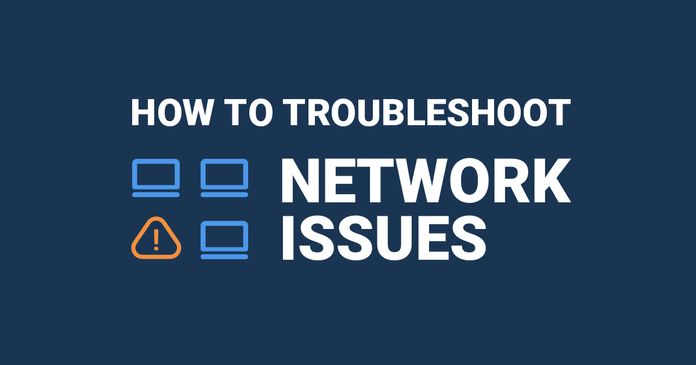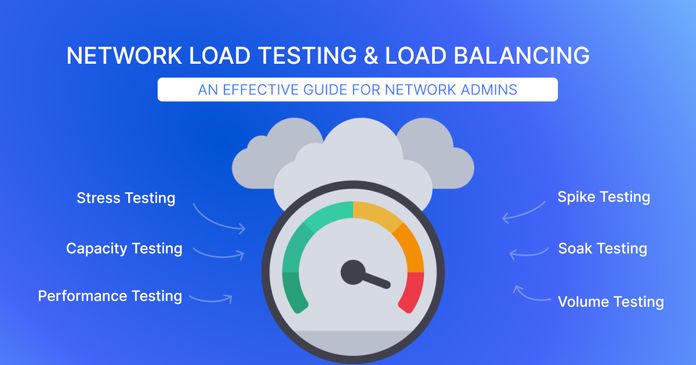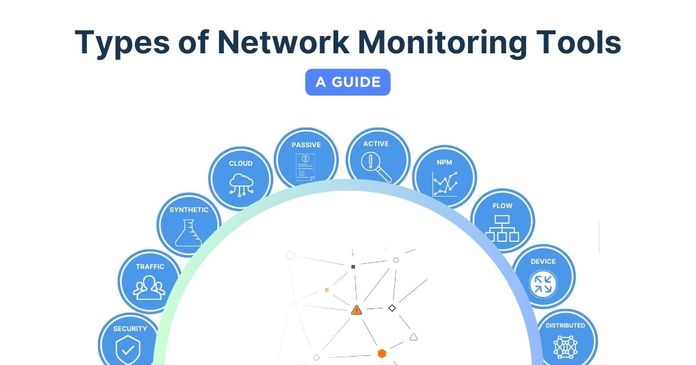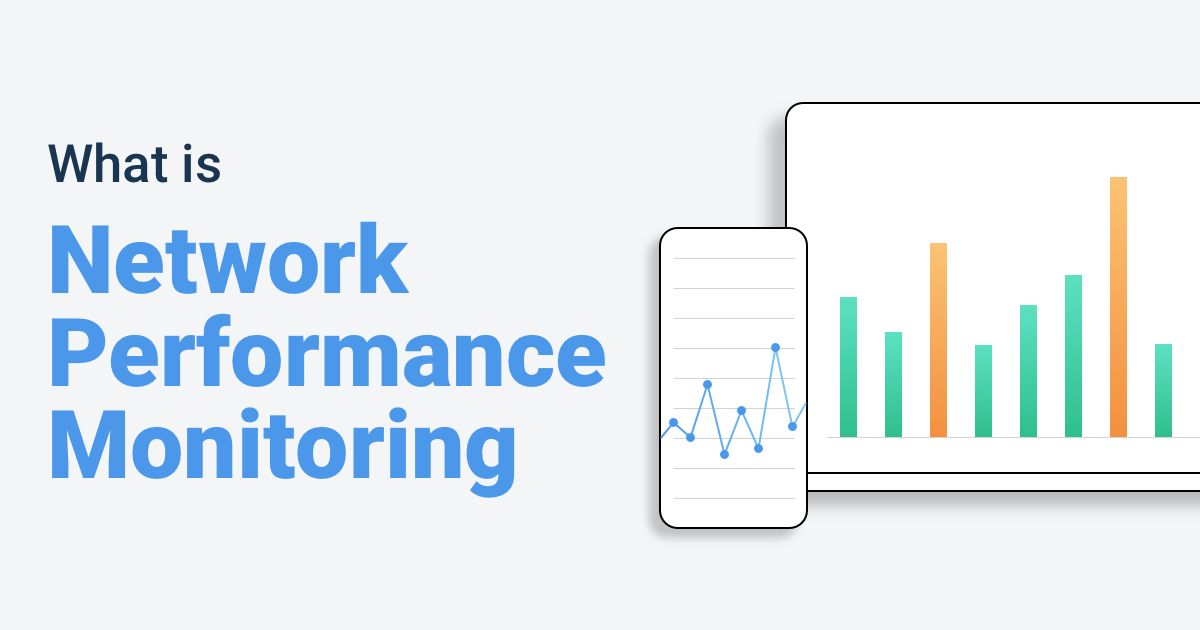Table of Contents
Table of Contents
Our networks are always changing and evolving. Network Testing for higher speeds, better application and network device performance, and after a new service deployment or migration, helps us understand the impact of changes on our network.
In this article, we’re running you through how to test network performance using Network Testing and Monitoring tools.
Network Testing (or network performance testing), similar to Software Testing, is the process of analyzing and testing your network using a network performance test to identify bugs and performance issues, evaluate large network changes, and measure network performance.
Even the most robust networks experience network problems.
That’s why before and after every new service migration or deployment, every new application or network device, and honestly - just as a continuous practice, perform a network performance test using Network Monitoring to detect and troubleshoot problems as soon as they happen.
Some key objectives of network testing include:
- Performance Evaluation: Network testing helps measure the network's performance in terms of speed, throughput, latency, and bandwidth. It assesses how well the network can handle the data traffic and whether it meets the performance expectations.
- Reliability and Availability: Network testing helps determine the network's reliability and network availability. This includes testing for uptime, redundancy, failover mechanisms, and the ability to recover from network failures.
- Security Assessment: Security is a critical aspect of network testing. It involves evaluating the network's vulnerability to security threats and assessing the effectiveness of security measures, such as firewalls, intrusion detection systems, and encryption protocols.
- Quality of Service (QoS): QoS testing evaluates the network's ability to prioritize and deliver different types of traffic with varying levels of service quality. This is important for ensuring that critical applications receive the necessary bandwidth and low latency.
- Load Testing: Load testing involves simulating heavy traffic conditions to determine how the network performs under peak usage. It helps identify performance degradation and helps in network capacity planning.
Network testing can help you ensure that your network is functioning properly, secure, and able to handle the needs of your organization, while also saving you time and money in the process.
There are several benefits of network testing. Here are some of the key ones:
- Identify and resolve issues: Network testing can help identify problems with the network before they become major issues. By detecting and addressing issues early on, you can prevent downtime, reduce the risk of security breaches, and ensure that the network is operating at optimal levels.
- Optimize network performance: Network testing can help you identify bottlenecks and other performance issues that may be slowing down the network. By optimizing the network's performance, you can ensure that it is able to handle the traffic and data transfer needs of your organization.
- Ensure network security: Network testing can help you identify security vulnerabilities in your network, such as open ports or weak passwords, that could be exploited by attackers. By addressing these vulnerabilities, you can reduce the risk of a security breach.
- Improve user experience: By optimizing the network's performance and ensuring that it is functioning properly, you can improve the user experience for employees, customers, and other stakeholders who rely on the network to access applications and data.
- Save time and money: Network testing can help you identify issues and make improvements more efficiently, which can save time and money in the long run. By preventing downtime and improving performance, you can also avoid the costs associated with lost productivity and revenue.

Now you may be wondering, What are the steps to perform a complete network performance test? Let's get into it.
Network testing can be demanding for a network admin. Knowing how to test a network requires a substantial amount of resources and manual effort. But, network monitoring tools can help.
Most traditional network monitoring solutions are passive, and only really monitor devices to notify you if they're up and running or not. But to actually test your network, you need to do better!
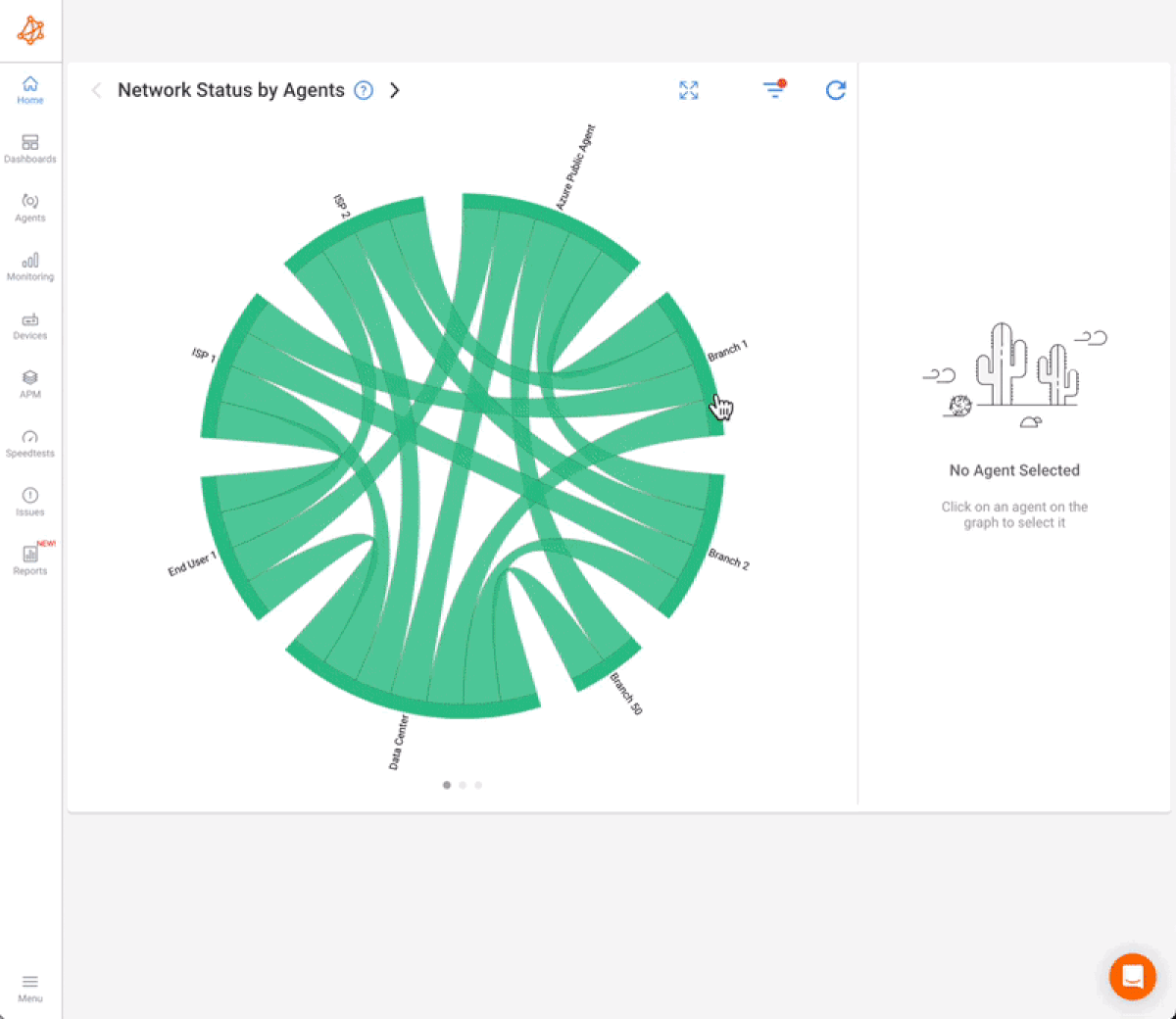
An tool like Obkio Network Performance Monitoring software:
- Monitors your complete network from the end-user perspective
- Perform continuous network performance tests (aka network performance testing)
- Measures key network metrics
With continuous network testing using Obkio, you get more detailed information about network problems affecting your network performance and impacting your end-users.

A Network Monitoring tool offers several benefits when used as a network testing tool. While its primary function is to provide continuous monitoring and real-time insights into the network's performance, it can be effectively utilized for testing and diagnosing network issues. Here are the key benefits of using a Network Monitoring tool for network testing:
- Real-time Visibility: A Network Testing tool with Network Monitoring constantly captures and analyzes network data in real-time. During testing, this real-time visibility allows testers to observe network behavior immediately, enabling them to detect anomalies and performance issues as they occur.
- Continuous Monitoring: Network Testing tools with Network Monitoring offer continuous monitoring capabilities, allowing testers to perform long-duration stability tests or observe the network's behavior under varying conditions over extended periods.
- Comprehensive Data Collection: Network Testing tools with Network Monitoring collect a wide range of data, including performance metrics, network utilization, traffic patterns, and more. This comprehensive data collection provides valuable insights during testing, helping testers assess multiple aspects of network performance.
- Historical Data Analysis: The historical data stored by Network Monitoring tools allows testers to analyze trends, patterns, and changes in network behavior over time. This historical analysis aids in identifying recurring issues, performance improvements, and long-term stability assessments.
- Alerting and Notifications: Many Network Testing tools with Network Monitoring have alerting and notification features. During testing, testers can set up network monitoring alerts to trigger when certain network conditions or thresholds are met, helping them respond promptly to any deviations from expected behavior.
- Resource Utilization Tracking: A Network Testing tool with Network Monitoring can track resource utilization, such as CPU usage and memory usage on network devices. This information helps testers understand how resource constraints may impact network performance during testing.
- Traffic Analysis: Network Testing tools with Network Monitoring often provide deep packet inspection and traffic analysis capabilities. Testers can use this feature to understand the types of traffic traversing the network during specific tests and identify potential bottlenecks.
- Visibility into Multi-location Networks: For organizations with distributed networks, Network Testing tools with Network Monitoring can offer centralized visibility into multiple locations, making it easier to conduct network testing and compare performance across different sites.
Using a Network Monitoring tool as a network testing tool allows testers to leverage its continuous monitoring, data analysis, and alerting features to assess the network's performance, identify potential issues, and ensure a stable and reliable network environment for users and applications.

Are you a network admin or IT pro looking to test network performance for your business, or a personal user trying to identify network performance issues for your remote work? Whether you need to monitor large networks or single-user workstations, Obkio's network monitoring tool has plans tailored for you. Find the right plan to help you test and optimize network performance now!
Obkio’s Network Monitoring Solution continuously tests and monitors your network performance by sending and monitoring data packets through your network using Network Monitoring Agents.
Network Monitoring Agents exchange synthetic traffic to continuously:
- Measure core network metrics
- Identify network problems
- Collect historical data
- Give you a real-time view of your network performance
For network testing (or network performance testing) with Obkio, it’s important to set up monitoring agents in your key network locations like on your workstation, at your company's head office, branch office, data center, private and public clouds, etc.
Set up your network testing for free -
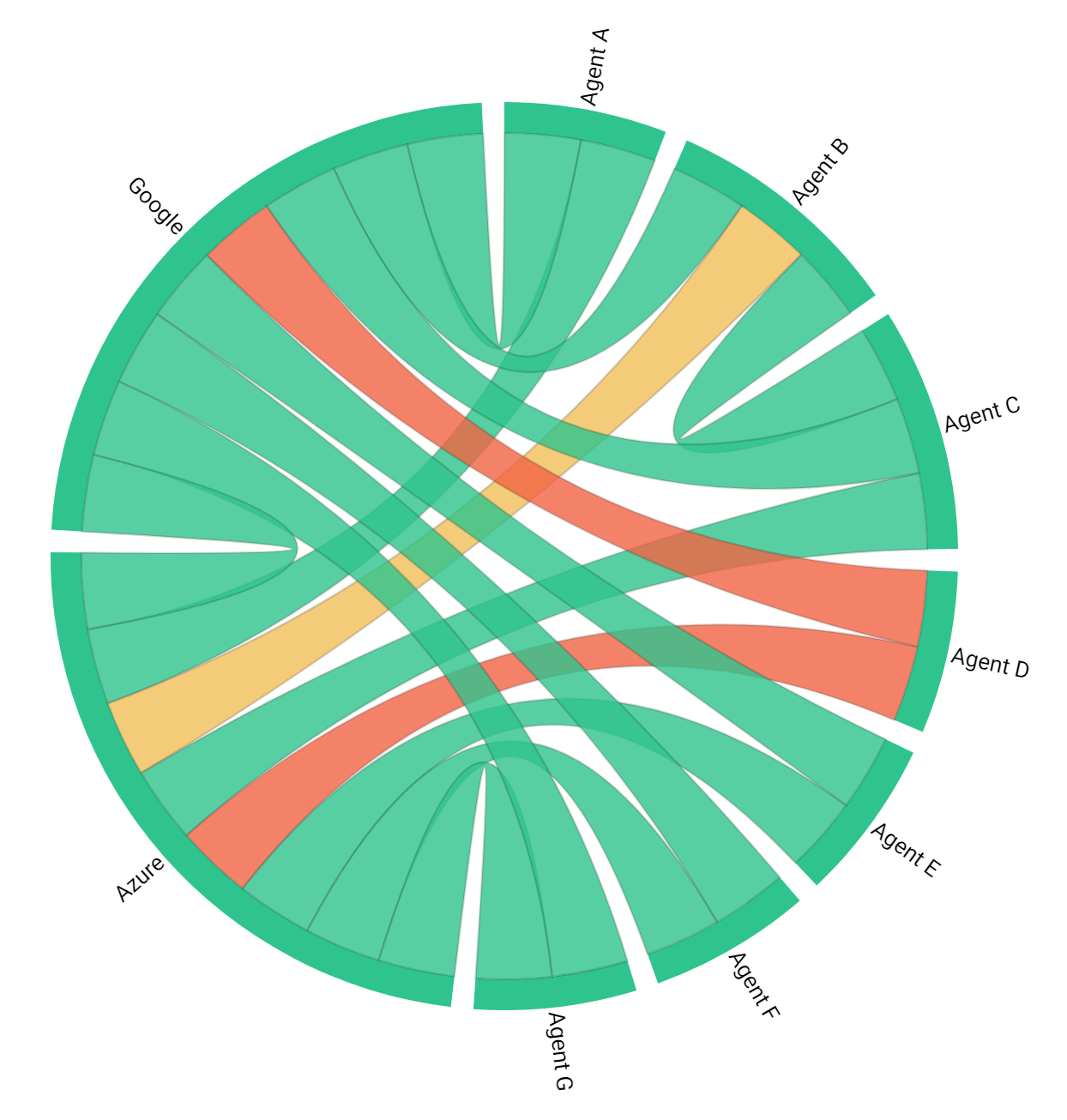
Before beginning any network testing, it is important to define the goals and requirements of the testing. This helps to ensure that the testing is focused and effective.
Here are some key considerations when defining testing goals and requirements:
- Identify the scope of the testing: The first step is to identify the scope of the testing. This may involve determining which parts of the network will be tested, which performance metrics will be evaluated, and what types of testing will be conducted (e.g. functional testing, performance testing, security testing, etc.).
- Define testing objectives: Once the scope has been identified, it is important to define the testing objectives. This may involve setting specific goals for network performance, identifying areas of the network that need improvement, or testing for compliance with industry standards or regulatory requirements.
- Establish success criteria: To ensure that the testing is effective, it is important to establish success criteria. This involves defining specific metrics or thresholds that must be met in order for the testing to be considered a success. For example, a performance testing goal might be to achieve a minimum bandwidth threshold or maximum latency threshold.
- Determine testing methodology: The testing methodology refers to the specific approach that will be used to conduct the testing. This may involve selecting testing tools, defining test scenarios, or establishing testing procedures.
- Define testing schedule: It is important to establish a testing schedule that allows for adequate time to conduct the testing and analyze the results. This may involve identifying specific dates for testing or establishing a testing timeline.
- Identify stakeholders: Finally, it is important to identify the stakeholders who will be involved in the testing. This may include network administrators, IT teams, management, or other stakeholders who will need to be informed of the testing results.
Once you’ve deployed Obkio Monitoring Agents in key network locations, they will test and measure key network metrics like:
- Jitter: Jitter is the variation in the delay of packet delivery in a network. In other words, it's the difference in the time it takes for packets to arrive at their destination. Jitter can cause issues with real-time applications such as voice over IP (VoIP) and video streaming. Network testing tools can measure jitter to help diagnose and troubleshoot network performance issues.
- Packet loss: Packet loss occurs when data packets are lost or dropped during transmission over a network. Packet loss can be caused by network congestion, faulty hardware, or poor network configurations. High packet loss can result in poor network performance and slow data transfer rates. Packet loss is an important metric for network testing as it helps to identify network issues that can impact overall network performance.
- Latency: Latency refers to the delay between the time when a packet is sent and when it is received. High latency can result in slow network performance, and can impact the user experience of applications such as video conferencing, online gaming, and VoIP (VoIP latency). Measuring latency is an important metric for network testing, as it helps to identify potential bottlenecks in the network that can impact overall performance.
- VoIP Quality: VoIP quality refers to the quality of voice calls over a network. Factors that can impact VoIP quality include latency, jitter, packet loss, and network congestion. Measuring VoIP quality with network and VoIP monitoring is an important metric for network testing, as it helps to identify network issues that can impact the user experience of voice calls.
- Throughput: Throughput refers to the amount of data that can be transferred over a network in a given amount of time. Measuring throughput is an important metric for network testing, as it helps to identify the maximum data transfer rate that can be achieved over a network.
- Network speed: Network speed refers to the maximum data transfer rate that can be achieved over a network. Network speed is an important metric for network testing, as it helps to identify the maximum performance that can be achieved over a network.
- And QoE: Quality of Experience (QoE) refers to the overall user experience of a network or application. Factors that can impact QoE include latency, jitter, packet loss, network congestion, and VoIP quality. Measuring QoE is an important metric for network testing, as it helps to identify network issues that can impact the user experience of applications and services.
And display them on Obkio’s Network Response Time Graph. Testing these network metrics allows you to proactively identify any performance degradation in your network, which may be a sign of a network issue arising, or an intermittent network problem in hiding.
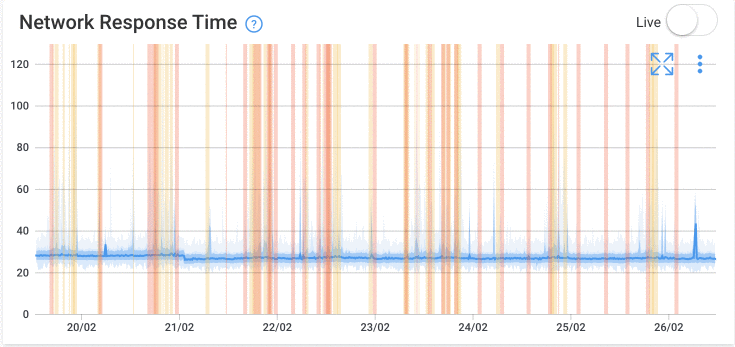

One of the main use cases for network testing (network performance testing) is to test your network when substantial changes occur.
Analyzing historical performance data is key to understanding how your network is performing before, after, and during big changes to your network infrastructure.
Obkio measures and collects historical network performance data for you so you can analyze, compare, and troubleshoot performance from the past.
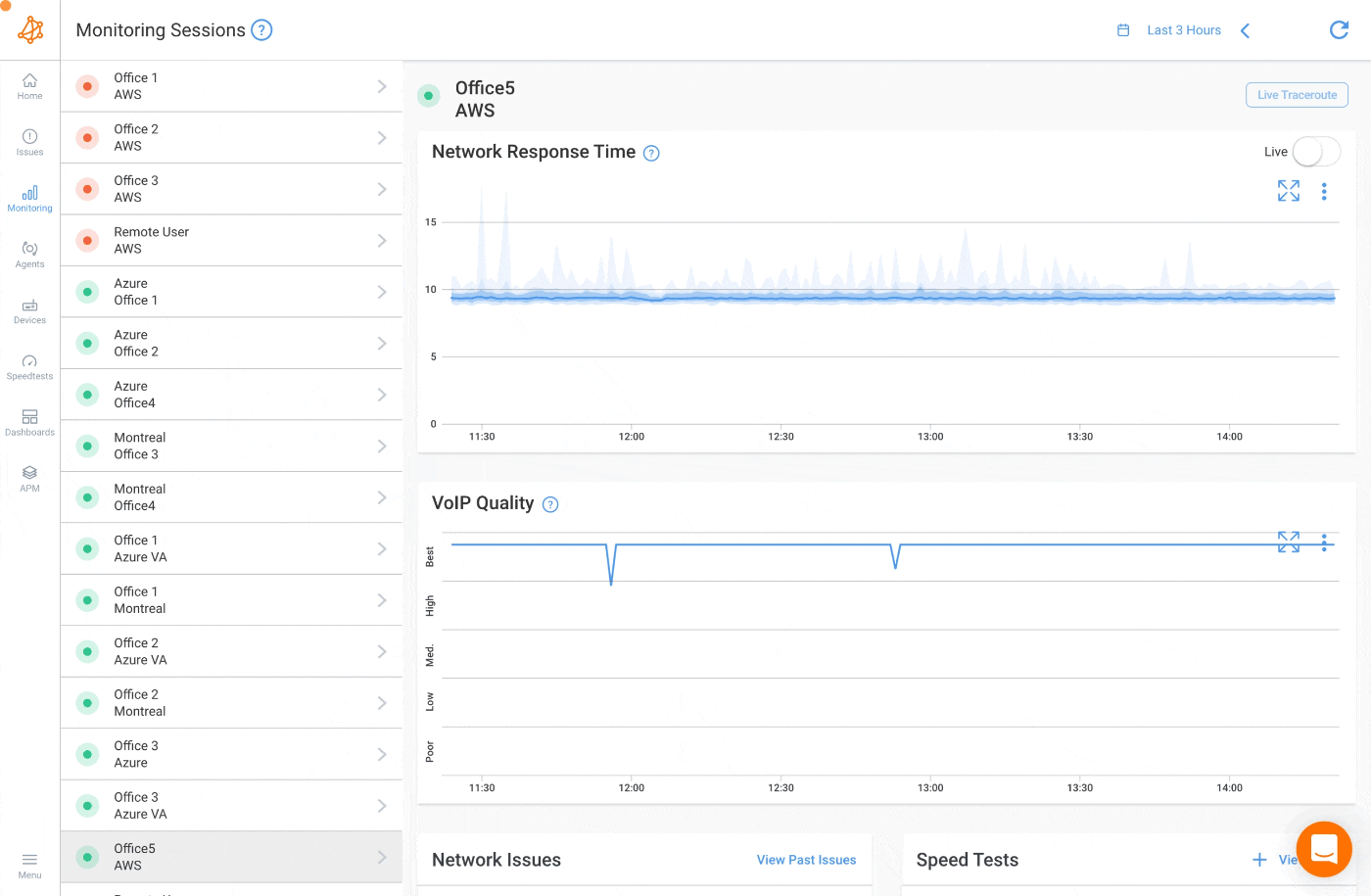
Go back in time to compare network performance before and after a new service migration or deployment, or pin a time range to find and troubleshoot intermittent network problems that pop up sporadically.
As we mentioned earlier, another common use case for network testing is to identify network issues or bugs which are bound to happen, even in the best performing networks.
With this end-to-end testing and monitoring setup, you can collect the data you need to identify and troubleshoot network problems to optimize network performance.
Here are some of the most common network problems to test for:
- Network Slowness: Network slowness occurs when a computer network is operating at a slower-than-normal speed, often resulting in sluggish internet browsing or delays in accessing files or applications.
- Latency: Latency is the time it takes for a message to travel from one point on the network to another. High latency can cause delays and slow down network performance, making it harder for users to access data and applications.
- Packet Loss: Packet loss occurs When packets of data are lost or dropped during transmission. It can lead to retransmissions, which can slow down network performance and increase latency. This can include both WAN and LAN congestion.
- Network Congestion: When there are too many devices using the same network resources, the available bandwidth can cause network congestion, cleading to slower network speeds and longer wait times.
- Packet Duplication: Packet duplication can occur when packets are duplicated during transmission, resulting in additional network traffic and potentially affecting network performance. When packets are duplicated, the receiving device may process the same data multiple times, leading to additional processing overhead.
- Packet Reordering: Packet reordering can occur when packets are received out of order. This can be caused by network congestion or delays in packet delivery. Packet reordering can cause additional processing overhead as the receiving device has to reorder the packets before processing them.
Obkio will also automatically alert you of events like packet loss between certain sites, or users experiencing high levels of jitter during VoIP calls, and more.
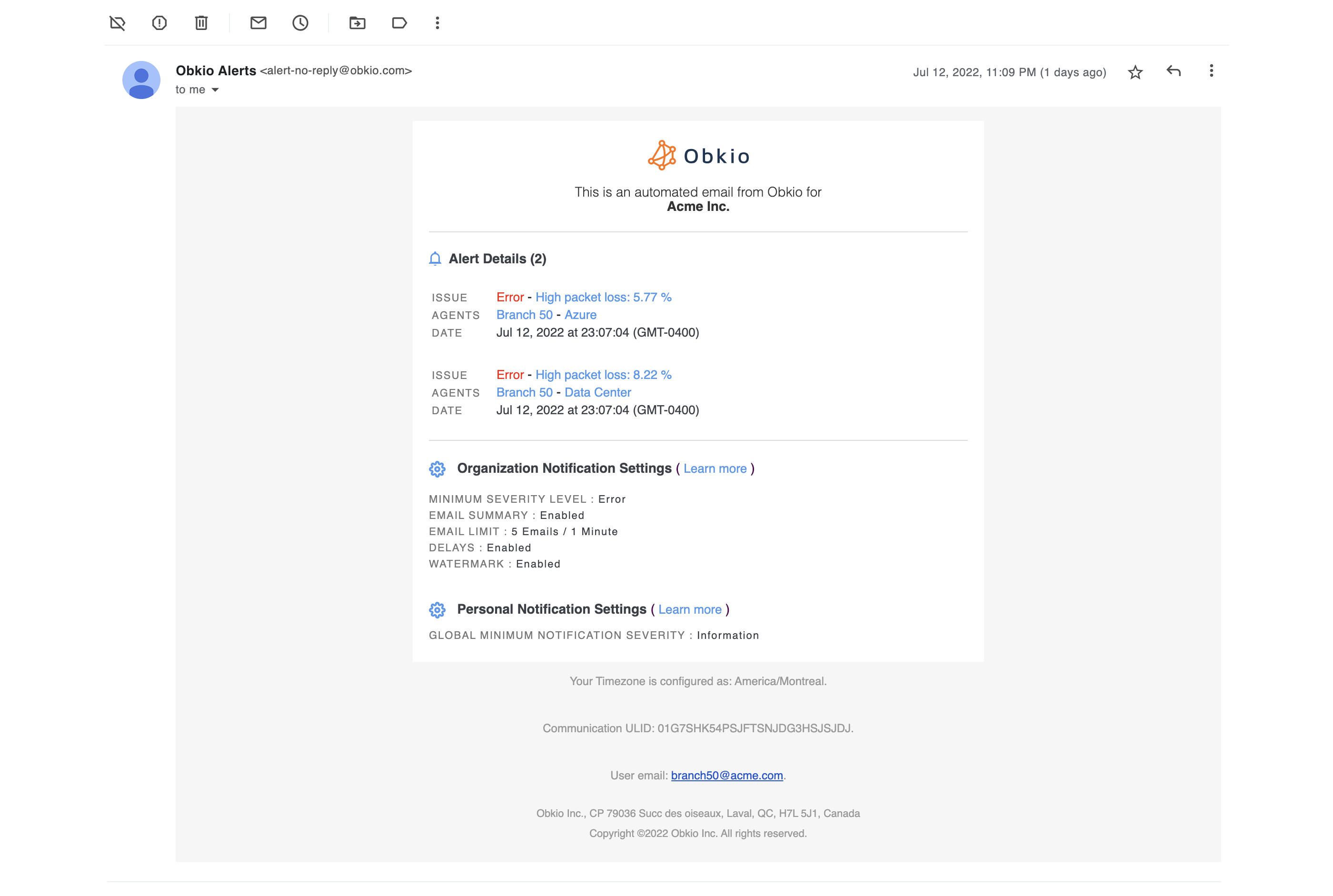
To identify the cause, source, time, and location of network problems, you can use network troubleshooting tools like:
- Traceroutes: to identify route, latency and packet loss between two sites and detect exactly where and when network problems happened. View traceroute results with Obkio Visual Traceroute tool.
- Speed Tests: which allow you to validate if the bandwidth you need is readily available.
- Prioritization and QoS: which increases network efficiency in the event of network congestion or network overload and prioritizes applications more critical or sensitive to performance problems such as VoIP (including VoIP PBX or video).
- Network Device Monitoring: to get detailed information about the health of network devices such as firewalls, routers, switches and wifi access points
Learn how to troubleshoot network issues by identifying where, what, why network problems occur with Network Troubleshooting tools.
Learn more

After testing your network performance, and identifying weaknesses, it's crucial to optimize network performance to ensure your network runs smoothly and meets your business needs. Below are some key strategies to consider:
- Troubleshoot network issues: Promptly resolving network problems can prevent them from affecting overall performance and ensure a smooth network operation.
- Verify network connections: Ensure that all network connections are correctly configured and functional. Check cables, routers, switches, and other hardware to ensure they are connected and configured properly.
- Upgrade network hardware: Updating network hardware can improve network performance. Consider upgrading to faster switches, routers, and servers, as well as increasing bandwidth and storage capacity.
- Optimize network settings: Fine-tuning network settings like packet and buffer sizes, and Quality of Service (QoS) settings can enhance network performance. Configuring QoS settings can prioritize essential traffic, reducing latency and improving user experience.
- Implement load balancing: Distribute network traffic across multiple servers to minimize server overload and enhance resource utilization. Network load balancing can reduce network congestion and minimize downtime.
- Use Content Delivery Networks (CDNs): CDNs deliver web content from the server closest to users, reducing latency and improving network performance.
- Implement Software-Defined Networking (SDN): SDN simplifies network management, control, and optimization, enhancing network performance and making your business more agile.
- Conduct regular network maintenance: Regular network maintenance, including monitoring network traffic, updating and patching, and keeping an eye out for potential issues, can prevent security threats and other issues that can affect network performance.

No matter how efficiently your network is performing, and how quickly you've troubleshooted performance issues - network problems can always come back.
Continuous network testing is essential for optimizing network performance and ensuring that the network meets business needs. To achieve this, it's important to have a dedicated team and solution that can continually work to optimize the network.
That's why Obkio is here to be your own personal network admin!
By implementing network testing tools such as Obkio, businesses can keep a permanent eye on their network, monitor network performance, and optimize it as needed. These tools can help businesses identify and address network issues promptly, prevent downtime, and ensure that the network is running at peak performance.
- Identifying issues before they become critical: Continuous network testing allows businesses to identify potential issues before they become critical. Early detection of issues enables prompt remediation, minimizing downtime and preventing damage to the network and business operations.
- Keeping up with changing network demands: As network demands change, continuous testing helps ensure that the network adapts to meet those demands. For example, if a business experiences a sudden surge in traffic, continuous testing can detect any network bottlenecks and help administrators quickly optimize the network to handle the increased traffic.
- Maximizing network performance: Continuous network testing helps ensure that the network is running at peak performance, delivering the speed, reliability, and security that the business needs to thrive. Regular testing and optimization can help reduce downtime, minimize latency, and enhance the user experience.
Network tests are essential for evaluating the performance, reliability, and security of computer networks. While, in this article, we talked more specifically about network performance tests, there are various types of network tests, each serving a specific purpose.
Keep in mind that some of the tests do overlap, and most businesses tend to run a variety of network tests simultaneously to get the most complete view of their network performance, availability, and reliability. Also note that you don't have to run each network test individually, as many network monitoring tools and network testing tools will run a variety of different network tests for you.
Without further ado, let's go get into the different types of network tests!
Network Performance Test is a comprehensive evaluation of a computer network's performance in terms of various metrics such as latency, throughput, packet loss, and response time. The primary objective of this test is to measure how well the network meets the requirements of its users and applications.
By conducting a network performance test, organizations can identify potential bottlenecks, optimize network resources, and ensure a smooth and efficient user experience.
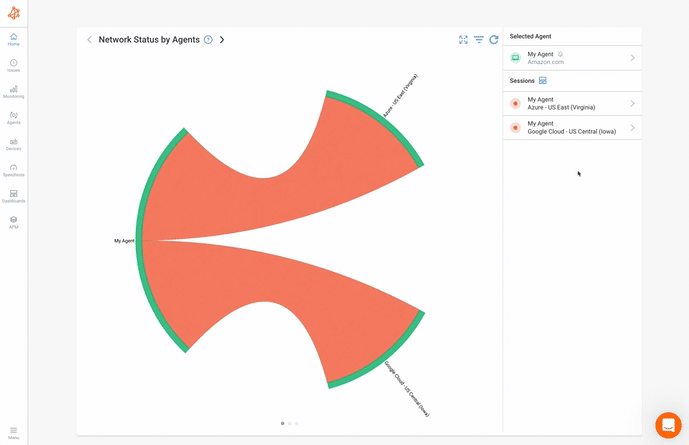

We’ve already covered Network Performance Tests in this article, but to recap, the key aspects of the Network Performance Test:
- Latency: Latency, also known as delay, is the time it takes for data to travel from the source to the destination. It is a critical factor in real-time applications like video conferencing, online gaming, and VoIP. Lower latency is desirable, as it reduces the time between sending a request and receiving a response.
- Throughput: Throughput measures the amount of data that can be transmitted over the network within a given time. It indicates the network's capacity and how well it can handle data traffic. High throughput is essential for applications that require significant data transfer, such as large file downloads or media streaming.
- Packet Loss: Packet loss occurs when data packets fail to reach their destination. It can be caused by network congestion, hardware issues, or other factors. Packet loss can lead to retransmissions and degraded application performance. Reducing packet loss is crucial for maintaining network efficiency.
- Response Time: Response time refers to the time it takes for a system or application to respond to a request. It is essential for applications where quick responses are necessary, such as web browsing or database queries.
- Bandwidth Utilization: This metric measures how efficiently the available bandwidth is utilized. High bandwidth utilization may indicate optimal network performance, but it can also lead to congestion and performance degradation if not managed properly.
- Quality of Service (QoS): QoS measures the network's ability to prioritize different types of traffic based on their importance. It ensures that critical applications and services receive sufficient resources to function properly.
- Network Congestion: Network performance tests help identify areas of network congestion, where the demand for resources exceeds the available capacity. Resolving congestion issues is crucial to maintaining network stability and high performance.
Network performance tests can be conducted using various tools and methodologies, including real-world traffic simulations, synthetic traffic generation (synthetic monitoring), and load testing. A Network Performance Monitoring tool, like Obkio, is the easiest and more complete way of continuously running network performance tests in your network.
Continuous monitoring and periodic testing are necessary to detect performance issues early on, allowing network administrators to implement necessary adjustments and optimizations. Monitor mutliple network types, apps and services with features for:
- Network Performance Monitoring
- Network Audits
- Cloud Network Monitoring
- VoIP Monitoring
- Remote Network Monitoring
- UC Monitoring
- SD-WAN Monitoring
- SD-WAN Migration Monitoring
- MPLS Network Monitoring
- Dual-WAN Monitoring
- Internet Monitoring
- Firewall Monitoring
- SASE Monitoring
A Network Bandwidth Test, also known as a bandwidth speed test, is a type of network test designed to measure the available bandwidth between two points in a computer network.
Bandwidth refers to the maximum data transfer rate that a network can support, usually expressed in bits per second (bps) or a variation of it like megabits per second (Mbps) or gigabits per second (Gbps).
The primary purpose of a Bandwidth Test is to determine how much data can be transmitted over the network within a specified time, helping to identify the network's capacity and potential bottlenecks. This information is crucial for network administrators and users to understand the network's performance capabilities, especially for data-intensive applications.
Here's how a Network Bandwidth Test works:
- Data Transfer: During the bandwidth test, a specific amount of data is transferred between the client (the device initiating the test) and the server (the device responding to the test request). The amount of data transmitted can vary, but it's typically a large enough sample to get accurate measurements.
- Measurement: The test measures the time it takes for the data to travel from the client to the server and back. By dividing the amount of data by the time taken, the test calculates the bandwidth or data transfer rate.
- Result: The result is typically expressed in Mbps or Gbps and represents the maximum data transfer rate achieved during the test. It reflects the network's capability to handle data traffic at that particular moment.
- Factors Affecting Test Results: Various factors can impact the results of a bandwidth test, including network congestion, server performance, client device capabilities, and overall internet connectivity. It's essential to consider these factors while interpreting the test results.
Bandwidth tests are readily available through various online tools and websites, where users can perform a quick test by clicking a button. There are also dedicated Network Bandwidth Testing tools or Network Monitoring tools, like Obkio, that allow network administrators to conduct more in-depth and controlled bandwidth tests within their local networks.
How to measure bandwidth, identify issues & optimize network performance. Use Obkio's Network Performance Monitoring tool for easy bandwidth monitoring.
Learn more

A Network Jitter Test is designed to measure the variation in packet delay within a computer network. Jitter is a critical factor in real-time applications, such as VoIP calls, video conferencing, and online gaming, where data needs to be transmitted and received consistently and without significant delays.
This is an especially important metric for Microsoft Teams monitoring or Zoom monitoring, since these apps are especially sensitive to jitter.
- How it works: During the Jitter Test, a series of data packets are sent from the source to the destination. The test measures the time it takes for each packet to reach its destination. By analyzing the variance in packet arrival times, the test calculates the jitter value.
- Measurement: Jitter is typically expressed in milliseconds (ms) and represents the difference between the highest and lowest packet delay times. Lower jitter values indicate a more stable network with consistent packet delivery, while higher jitter values imply a less reliable network that might experience delays and packet loss.
- Impact: Excessive jitter can lead to issues in real-time applications, causing audio or video distortion, delays in communication, and overall degraded user experience. Network administrators use jitter tests to identify and mitigate jitter-related problems to ensure smooth and uninterrupted performance of time-sensitive applications.
By conducting periodic Network Jitter Tests, network administrators can pinpoint and resolve network issues affecting real-time applications, ensuring a higher quality of service and enhanced user satisfaction. Jitter tests can be performed using a Network Monitoring tool like Obkio, which continuously measures jitter for key applications and services.
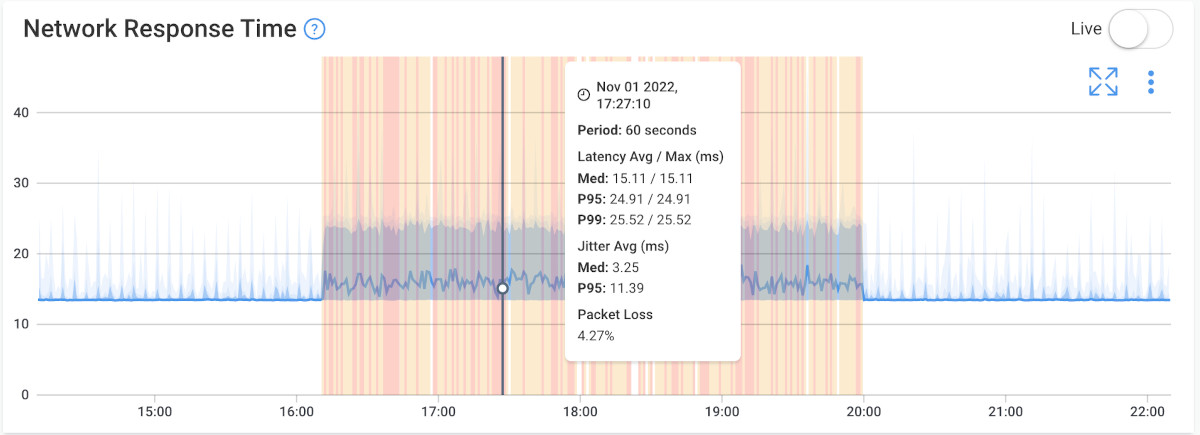
Packet Loss Test is performed to assess the percentage of data packets that fail to reach their destination within a computer network. Packet loss can occur due to various reasons, such as network congestion, hardware problems, or configuration issues.
This test is crucial because excessive packet loss can lead to degraded performance, retransmissions, and a poor user experience, particularly in real-time applications like VoIP, online gaming, and video streaming.
- How it works: During the Packet Loss Test, a set of data packets is sent from the source to the destination. The test then compares the number of packets sent with the number of packets received at the destination. The difference between the two represents the packet loss rate.
- Measurement: Packet loss is typically expressed as a percentage, calculated by dividing the number of lost packets by the total number of packets sent and multiplying by 100. For example, if 10 packets were sent, and only 8 were received, the packet loss rate would be (10 - 8) / 10 * 100 = 20%.
- Impact: Excessive packet loss can significantly impact network performance. It leads to retransmissions, which increase network congestion and delay data delivery. In real-time applications like VoIP, packet loss can cause voice distortion or dropouts, while in video streaming, it can result in buffering or lower video quality.
- Troubleshooting: Packet loss tests help network administrators identify areas of the network where packet loss is occurring. Once identified, they can work to resolve the underlying issues, such as addressing network congestion, upgrading hardware, or optimizing network configurations.
Regularly conducting Packet Loss Tests is essential for maintaining a stable and reliable network and can be performed using a Network Monitoring tool like Obkio. By addressing packet loss issues promptly, network administrators can enhance network performance, improve the user experience, and ensure the efficient delivery of data across the network.
Network Throughput Tests assess the actual data transfer rate or the amount of data, network throughput, that can be transmitted over a network within a given time. Throughput testing is crucial for understanding the network's capacity and performance, helping to identify any potential bottlenecks that may limit data flow.
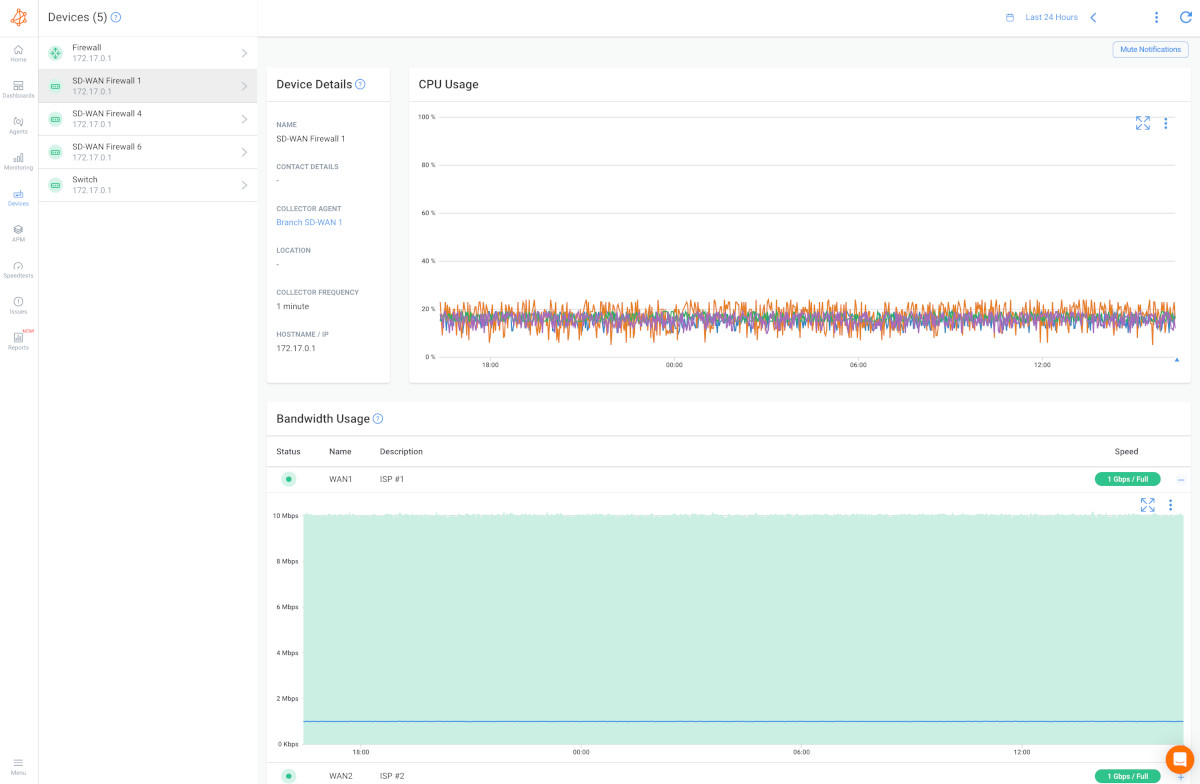
- Measurement: Throughput is measured in bits per second (bps), kilobits per second (Kbps), megabits per second (Mbps), or gigabits per second (Gbps). The testing involves transferring a specific amount of data from one point to another and measuring the time taken for the data transfer.
- Factors Affecting Throughput: Several factors can impact network throughput, including network congestion, hardware capabilities, link quality, packet loss, and network configuration. Throughput tests help identify the factors limiting data transmission speed.
- Throughput vs. Bandwidth: Throughput and bandwidth are related but distinct concepts. Bandwidth refers to the maximum network capacity of the network, while throughput measures the actual data transfer rate achieved in practice. Throughput is typically lower than the available bandwidth due to various factors like network overhead and contention.
- Network Throughput Testing Tools: Network Throughput tests can be conducted using various network throughput testing tools and methodologies. For example, Network Monitoring tools like Obkio measure throughput and network performance between different network locations, devices, and applications. There are also web-based tools and software applications designed specifically for throughput testing.
Network Throughput Tests are vital for understanding the network's data transmission capabilities and ensuring optimal performance. By regularly conducting throughput tests, network administrators can make informed decisions, optimize network resources, and deliver a smoother and more efficient user experience.
Network Load Testing is a type of performance testing that evaluates a computer network's behaviour and capacity under various levels of traffic or load. The objective of load testing is to assess how well the network performs when subjected to realistic or maximum user activity, ensuring it can handle the expected or peak data demands without degradation or failure.
- Testing Scenario: Load testing involves simulating real-world traffic conditions by generating a significant number of data requests or transactions on the network. The testing scenario can vary depending on the network's intended use, such as web browsing, file transfers, database queries, or a combination of different applications.
- Load Levels: Load testing can be done at different levels, starting from a normal load (typical user activity) to high-load scenarios that push the network to its maximum capacity. Testing at different load levels helps determine how the network behaves under varying conditions.
- Metrics Monitored: During network load testing, several metrics are monitored, including response time, throughput, latency, packet loss, and error rates. These metrics provide insights into the network's performance and its ability to handle the load effectively.
- Network Load Testing Tools: Load testing tools are used to simulate the network traffic and generate the desired load. These tools can vary from open-source solutions like Apache JMeter to commercial products that offer more advanced features and reporting capabilities.
- Benefits: Load testing is crucial for identifying and resolving performance bottlenecks before they impact real users. It helps network administrators optimize the network infrastructure, allocate resources efficiently, and plan for future capacity requirements.
- Scalability Testing: Load testing is often part of scalability testing, which assesses how well the network can handle an increasing number of users or data volume. Scalability testing helps organizations plan for growth and ensure the network can scale up to meet expanding needs.
- Continuous Monitoring: Load testing is not a one-time event. Networks evolve, and user demands change over time. Continuous monitoring and periodic load testing are essential to ensure ongoing network performance and to adapt to changing usage patterns.
In summary, network load testing is a vital process to validate a network's performance, scalability, and reliability under various traffic conditions. By conducting load testing regularly, organizations can optimize their network infrastructure, deliver a better user experience, and ensure the smooth functioning of their applications and services.
Explore the world of network administration with insights on network load testing, network load balancing, and the role of NPM. Optimize your network today!
Learn more

Network Traffic Tests evaluate and analyze the flow of data packets within a computer network. These tests help monitor network behaviour, identify data transfer patterns, and pinpoint potential issues or irregularities in data transmission.
Network Traffic Tests involve capturing and inspecting network packets using tools like packet sniffers. These tools capture packets in real-time, providing information about the source, destination, size, and type of data being transmitted.
There are several methods and tools available to generate network traffic, depending on the specific testing requirements.
- Synthetic Traffic Generation: Synthetic traffic is generated using specialized tools or software, like Obkio’s synthetic network monitoring tool, that creates data packets with specific characteristics, such as packet size, protocol, and transmission rates. These packets are not generated by real user activities but are designed to simulate different types of network traffic.
- Network Load Testing Tools: Load testing tools like Apache JMeter, Gatling, or Locust are designed to simulate multiple users or devices generating traffic to test the network's performance under various load conditions. These tools can mimic user behaviour and generate concurrent requests to specific endpoints or applications.
- Ping Flood: Ping flood is a simple method to generate network traffic by sending a large number of ICMP echo requests (pings) to a target device or IP address. This can be done using the 'ping' command with a high number of requests.
- File Transfers: Transferring large files across the network can generate substantial traffic. Tools like FileZilla or SCP (Secure Copy) can be used to transfer files between devices, creating significant data flow.
- Video Streaming: Streaming high-definition videos or multimedia content over the network can generate data-intensive traffic. Services like YouTube or video conferencing tools can be used for this purpose.
- Network Stress Testing Tools: Tools like iperf or hping can be used for stress testing a network by generating high volumes of traffic between devices.
- Web Browsing: Opening multiple browser sessions and accessing various websites can simulate web traffic within the network.
- VoIP and Video Calls: Conducting VoIP or video calls using applications like Skype or Zoom can generate real-time traffic and test the network's ability to handle real-time communication.
- Custom Scripts: For specific testing scenarios, custom scripts can be written to generate network traffic tailored to the testing requirements.
Learn how to use synthetic monitoring to monitor network performance & identify network issues, and the benefits of synthetic traffic over packet capture.
Learn more

Network Stress Tests, also known as network load stress tests, are a type of performance testing designed to evaluate how a computer network performs under extreme and demanding conditions. The primary objective of stress testing is to determine the network's stability, capacity, and resilience by subjecting it to traffic levels that go beyond its normal operational limits.
- Testing Scenarios: Stress tests create scenarios where network resources are pushed to their limits. This can involve generating significantly higher data traffic, increasing the number of concurrent users, or replicating multiple demanding applications running simultaneously.
- Traffic Simulation: Stress testing tools are used to simulate a massive volume of data traffic, generating intense network activity to measure how the network responds under the load.
- Performance Metrics: During stress testing, various performance metrics are measured, such as network response time, throughput, latency, packet loss, and resource utilization. These metrics help identify where the network begins to show signs of stress and potential failure points.
It's essential to carefully plan and execute stress tests to avoid causing disruptions or damage to the network. Stress testing should be conducted in controlled environments or with network segments specifically designated for testing purposes.
Network Stability Tests evaluate the reliability and consistency of a computer network over an extended period. The primary objective of stability testing is to identify potential issues related to network performance, connectivity, and uptime. This testing is crucial for ensuring that the network remains stable and operates without interruptions under normal operating conditions.
Checking network stability involves monitoring and assessing various performance metrics over an extended period to ensure the network maintains a consistent and reliable connection.
- Define Stability Metrics: Determine the key performance metrics that indicate network stability, such as latency, packet loss, uptime, response time, and jitter. These metrics provide valuable insights into the network's overall performance and behaviour.
- Continuous Monitoring: Implement continuous network monitoring using network monitoring tools or software. These tools track and record the defined stability metrics over time, allowing you to analyze historical data and identify trends or fluctuations.
- Baseline Measurement: Establish a performance baseline for your network by recording stability metrics during periods of normal operation. This network baseline will serve as a reference for comparison during stability testing.
- Scheduled Stability Tests: Conduct scheduled stability tests over an extended period, such as several hours or days. During these tests, monitor the network performance closely to identify any inconsistencies, fluctuations, or patterns that may indicate instability.
- Analyze Test Results: After conducting stability tests, analyze the collected data and compare it to the established baseline. Look for any significant deviations from normal behaviour and investigate the possible causes of instability.
- Identify Patterns: Pay attention to patterns of instability that may occur at specific times or under certain conditions. For example, instability might coincide with high traffic loads, specific applications' usage, or particular network segments.
- Stress Testing: Consider performing stress testing to evaluate how the network behaves under extreme conditions and verify its stability when subjected to heavy traffic loads.
- Redundancy and Failover: Assess the effectiveness of redundancy and network failover mechanisms in place to ensure high availability and network resilience during stability tests.
- User Feedback: Keep an eye on user feedback and reports of network issues to complement the stability testing. Users may experience intermittent problems that stability tests might not capture.


Network Quality Tests, also known as network performance tests or service quality tests, assess the overall quality of a computer network's services and user experience. These tests focus on evaluating the network's ability to deliver reliable, consistent, and high-performance services to users and applications.
- Real-world Simulation: Network quality tests aim to replicate real-world usage scenarios, simulating how users interact with the network and its services in various situations.
- Application-Centric: Quality tests are application-centric, meaning they focus on assessing the performance of specific applications, such as web browsing, video streaming, VoIP, file transfers, etc., under different network conditions.
- Performance Metrics: Various performance metrics are used to evaluate network quality, including latency, throughput, jitter, packet loss, response time, and application-specific metrics like video buffering or call quality in VoIP.
- User Experience Evaluation: Beyond technical metrics, network quality tests take into account the user experience, subjective feedback, and perceived performance.
- Multi-Location Testing: Network quality tests are often conducted from different locations, representing various user environments and network conditions.
- Continuous Monitoring: Quality tests can be performed periodically or continuously to ensure ongoing evaluation and early detection of performance degradation.
- Benchmarking and Comparison: Network quality tests help benchmark the network's performance against industry standards or competitor networks, enabling organizations to identify areas for improvement.
Network Quality Tests are crucial for providing a consistent and reliable user experience. By regularly conducting these tests, network administrators can identify areas of improvement, optimize network performance, and ensure that the network meets the expectations of its users and applications.
Network Availability Tests are conducted to assess the uptime and accessibility of a computer network and its services. The primary objective of availability testing is to ensure that the network is consistently available to users and that critical services remain accessible, minimizing any potential network downtime or disruptions.
- Test Scenarios: Availability tests simulate various scenarios to check the network's response to different conditions, such as peak usage hours, heavy data traffic, or unexpected network failures.
- Uptime Monitoring: Continuous monitoring tools track the network's uptime and record any incidents of downtime or unavailability. The goal is to minimize downtime and achieve a high level of network reliability.
- Service Accessibility: Availability tests ensure that critical network services, such as web servers, email servers, and application servers, are reachable and respond promptly to user requests.
- Redundancy and Failover Testing: These tests assess the effectiveness of redundancy and failover mechanisms in maintaining service availability in case of hardware or network failures.
By conducting Network Availability Tests, network administrators can proactively detect and resolve potential availability issues, improve network reliability, and maintain a stable and accessible network environment for users and critical services.
Throughout this article we discussed how Network Testing is a critical aspect of maintaining and optimizing computer networks. When it comes to actually testing your network, various Network Testing tools play a pivotal role in assessing, monitoring, and troubleshooting network performance, security, and reliability. Whether you are a network administrator striving to ensure seamless operations, a security professional seeking to identify vulnerabilities, or an IT manager aiming to optimize resource allocation, there is a diverse array of network testing tools at your disposal.
In this section, we will delve into the different types of network testing tools, providing comprehensive insights into their functions and applications. From basic diagnostic utilities to advanced security scanners and performance monitoring platforms, understanding the capabilities of these tools is essential for effective network management and cybersecurity.
1. Network Performance Monitoring Tools:
Network performance monitoring tools continuously track various network performance metrics, including latency, packet loss, and bandwidth utilization. They provide real-time visibility into network health, aiding in proactive issue detection and resolution.
Throughput this aricle, we taught you how to test network performance using Obkio's Network Performance Monitoring tool. That's because this technique gives you the most complete view of your network performance, and allows you to continuously test your network without manual tests. NPM tools give you a complete overview of your network performance, from your LAN to WAN and network devices, and allows you to detect network issues anywhere.
2. Ping and Traceroute Tools:
These basic utilities are used to test network connectivity and diagnose network latency issues.
- Ping: This tool sends ICMP (Internet Control Message Protocol) echo requests to a target device or host and measures the network round-trip time for responses. It helps verify if a host is reachable and assesses network latency.
- Traceroute: Traceroute traces the route that packets take from the source to the destination by sending ICMP packets with incrementally increasing TTL (Time-to-Live) values. It displays each hop's IP address and response time, aiding in diagnosing routing issues.
3. Network Scanners:
Network scanners actively probe a network to identify devices, open ports, and services running on those ports. They provide valuable information for network inventory, security assessments, network risk assessments and vulnerability detection.
4. Packet Capture and Analysis Tools:
Packet capture tools capture network packets as they traverse the network. They allow users to inspect the packet contents, dissect protocols, and analyze traffic patterns. This helps troubleshoot network issues, identify anomalies, and detect security threats.
5. Bandwidth Monitoring Tools:
Bandwidth monitoring tool continuously monitor network traffic and provide data on bandwidth usage, application usage, and traffic trends. Network administrators use this data for capacity planning, traffic optimization, and cost management.
6. Network Load Testing Tools:
Load testing tools simulate heavy network traffic by generating synthetic traffic patterns. They evaluate a network's capacity, performance under stress, and its ability to handle peak loads. Results help in capacity planning and resource allocation.
7. Network Monitoring and Management Platforms:
Comprehensive network monitoring and management platforms offer a centralized dashboard to monitor device status, performance metrics, and configurations. They often provide alerting, reporting, and automation capabilities to ensure efficient network management.
8. Vulnerability Assessment Tools:
Vulnerability assessment tools scan networks for known security vulnerabilities and weaknesses. They generate reports and recommendations for remediation, helping organizations enhance network security.
9. Firewall and Security Testing Tools:
These tools assess firewall configurations and policies to ensure they comply with security best practices. They also identify potential security holes, misconfigurations, and rule violations.
10. Wireless Network Testing Tools:
Wireless network testing tools evaluate Wi-Fi coverage, signal strength, and interference. They help optimize access point placement, minimize dead zones, and improve overall wireless network performance.
11. VoIP Testing Tools:
VoIP testing tools measure the quality and reliability of Voice over IP (VoIP) and Unified Communications (UC) systems. They assess call quality, latency, jitter, and packet loss to ensure a smooth user experience.
12. Network Configuration Management Tools:
Configuration management tools track changes to network device configurations. They help maintain configuration consistency, provide backup and version control, and ensure compliance with organizational standards.
13. Penetration Testing Tools:
Penetration testing tools simulate cyberattacks to identify vulnerabilities in networks, applications, and systems. They help organizations proactively address security weaknesses and improve their overall security posture.
14. Traffic Generators:
Traffic generator tools create artificial network traffic to test how a network handles different loads and conditions. This can also be referred to as Synthetic Testing. They can assess Quality of Service (QoS), load balancing, and network resiliency.
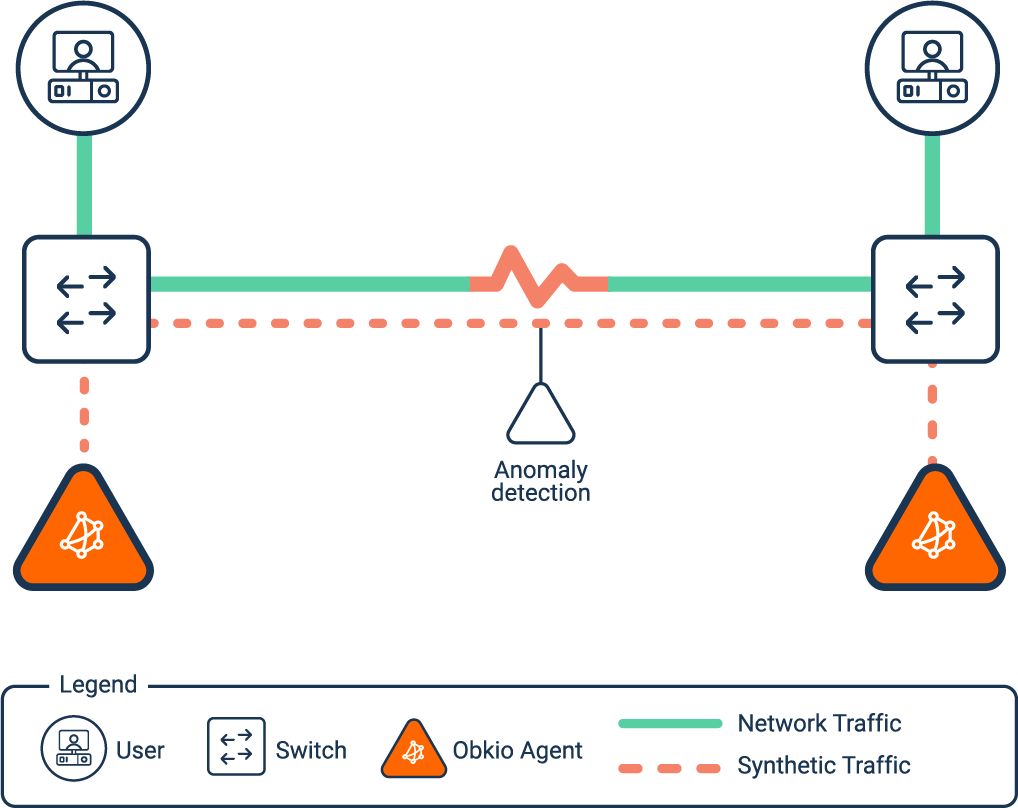
15. DNS and DHCP Testing Tools:
These tools diagnose issues related to DNS and DHCP services. They verify DNS resolution, test DHCP lease assignment, and help troubleshoot DNS and DHCP configuration problems.
16. Web Application Testing Tools:
Web application testing tools assess the security of web applications by scanning for vulnerabilities such as SQL injection, cross-site scripting (XSS), and authentication issues. They help developers and security teams identify and remediate weaknesses. These tools are often referred to as DAST tools, playing a critical role in detecting vulnerabilities during runtime and improving application security.
Each of these network testing tools serves a specific purpose in network management, monitoring, and security, contributing to the overall stability and effectiveness of computer networks. The selection of tools depends on the specific goals and requirements of network administrators and engineers.
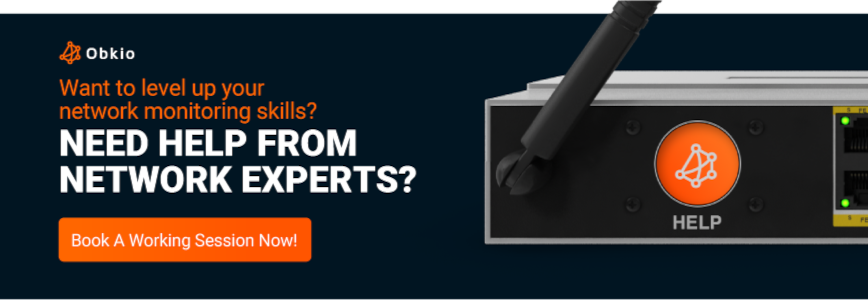
In the world of network management, there are two key types of tools you should know about: 'Network Testing Tools' and 'Network Performance Testing Tools.' They might sound similar, but they have distinct roles.
In this section, we'll break down the differences between them. 'Network Testing Tools' are like the Swiss Army knives of network maintenance, used for various tasks like security checks and configuration management. On the other hand, 'Network Performance Testing Tools' are like the speedometers of the network world, focused mainly on gauging and improving network speed and reliability.
By understanding these tools and what they do, you'll be better equipped to keep your network running smoothly and securely.
Network testing tools encompass a broad category of software or hardware tools used to evaluate various aspects of a computer network. Their primary goal is to assess network functionality, reliability, security, and other aspects. These tools are versatile and can be used for various network testing and troubleshooting tasks.
Network testing tools can include ping, traceroute, network scanners, packet capture and analysis tools, vulnerability assessment tools, security testing tools, configuration management tools, and more. They serve purposes ranging from connectivity testing to security assessment to configuration management.
Network performance testing tools are a subset of network testing tools specifically designed to assess and optimize the performance of a network. Their primary focus is on measuring and improving aspects like latency, bandwidth, throughput, and Quality of Service (QoS). These tools are particularly valuable for ensuring networks meet performance expectations.
Network performance testing tools include tools for bandwidth monitoring, load testing, traffic generation, and continuous network performance monitoring. They help network administrators and engineers evaluate how well a network performs under different conditions, simulate heavy traffic, detect bottlenecks, and ensure the network meets performance requirements.
In summary, while network testing tools encompass a wide range of utilities used for assessing various aspects of a network (including functionality, security, and configuration), network performance testing tools are a specific subset of these tools that focus primarily on measuring and optimizing network performance metrics. Both types of tools are valuable for network management and maintenance, but they serve different purposes within the broader field of network testing and monitoring.
Discover the superheroes of network monitoring tools in our comprehensive guide. Unveil the perfect type of network monitoring tool for your business.
Learn more

Testing network performance without impacting users requires strategic planning and the use of non-intrusive tools and techniques like synthetic monitoring and testing during off-peak hours. Here's how you can ensure your tests run smoothly without causing downtime or noticeable slowdowns:
1. Use Synthetic Monitoring Tools: Synthetic monitoring generates test traffic that mimics real user behavior without interfering with actual user activity or capturing real traffic. Tools like Obkioallow you to simulate network usage during off-peak hours or in controlled intervals.
2. Schedule Tests During Off-Peak Hours: Conduct performance tests when network usage is at its lowest, such as late at night or early morning. This reduces the chance of impacting active users.
3. Isolate Test Environments: Segment your network for testing purposes. Use VLANs (Virtual Local Area Networks) or a separate test environment to run performance checks.
4. Monitor Instead of Testing: Instead of actively testing, use network monitoring tools to passively observe performance metrics like latency, jitter, and packet loss in real time. Passive monitoring doesn’t introduce extra traffic to the network.
Yes, you can automate network testing, and it’s one of the best ways to ensure consistent, accurate insights into your network’s health over time. Automation allows you to schedule tests, collect data continuously, and receive alerts without manual intervention.
1. Use Network Performance Monitoring Tools with Automation Features: Modern tools like Obkio include automation features that continuously monitor network performance. These tools can schedule tests, run diagnostics, and provide alerts when performance degrades.
2. Schedule Regular Tests: Many tools let you set up recurring tests, such as:
- Speed tests every hour.
- Packet loss and latency measurements every minute.
- Performance checks during off-peak hours.
3. Configure Alerts for Performance Issues: Set up threshold-based alerts for key performance metrics like latency, bandwidth utilization, or jitter. Automated notifications ensure you’re informed immediately when something goes wrong.
The key difference between synthetic and real-user network testing tools lies in how they gather data and the type of insights they provide about network performance:
Synthetic Network Testing Tools: Synthetic testing tools generate simulated traffic to actively test network performance. They send test packets between predefined points and measure metrics like latency, jitter, packet loss, and throughput.
- Proactive Monitoring: Runs tests 24/7, even when no real users are active.
- Controlled Environment: Uses predefined scenarios to isolate issues.
- Customizable Tests: Allows you to simulate specific types of traffic, such as VoIP or video conferencing, to evaluate performance under controlled conditions.
Real-User Network Testing Tools: Real-user monitoring (RUM) tools analyze actual user traffic as it flows through the network. These tools collect data passively to provide insights into the performance experienced by end-users.
- Reactive Monitoring: Monitors real-world usage and provides insights based on actual user behavior.
- Real-World Scenarios: Reflects the true experience of users under varying network conditions.
- Non-Intrusive: Doesn’t generate extra traffic; instead, it observes existing data.
Choosing the Right Tool
Go Synthetic If:
- You want to proactively identify issues before they affect users.
- You need consistent, repeatable tests to benchmark performance.
- You're monitoring critical services like VoIP or cloud apps.
Go Real-User If:
- You’re focused on understanding the end-user experience.
- You need insights from actual application usage.
- You’re diagnosing user-reported issues.
With our growing reliance on a high performing network to run cloud applications, communicate virtually and manage our businesses, network testing and monitoring is more important than ever.
With a network monitoring solution, you can continuously test your network so you always have visibility over changes, problems, and areas for improvement.
To set up network monitoring to test, diagnose, and troubleshoot your network, get started for free with Obkio’s Free Trial!

- 14-day free trial of all premium features
- Deploy in just 10 minutes
- Monitor performance in all key network locations
- Measure real-time network metrics
- Identify and troubleshoot live network problems



























 Obkio Blog
Obkio Blog






